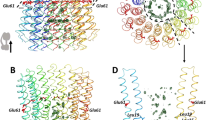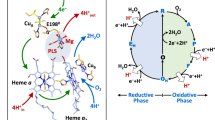Abstract
The tertiary fold of the ε subunit of the Escherichia coli F1F0 ATPsynthase (ECF1F0) has been determined by two- and three-dimensional heteronuclear (13C, 15N) NMR spectroscopy. The ε subunit exhibits a distinct two domain structure, with the N-terminal 84 residues of the protein forming a 10-stranded β-structure, and with the C-terminal 48 amino acids arranged as two α-helices running antiparallel to one another (two helix hairpin). The β-domain folds as a β-sandwich with a hydrophobic interior between the two layers of the sandwich. The C-terminal two-helix hairpin folds back to the N-terminal domain and interacts with one side of the β-domain. The arrangement of the ε subunit in the intact F1F0 ATP synthase involves interaction of the two helix hairpin with the F1 part, and binding of the open side of the β-sandwich to the c subunits of the membrane-embedded F0 part.
This is a preview of subscription content, access via your institution
Access options
Subscribe to this journal
Receive 12 print issues and online access
$189.00 per year
only $15.75 per issue
Buy this article
- Purchase on Springer Link
- Instant access to full article PDF
Prices may be subject to local taxes which are calculated during checkout
Similar content being viewed by others
References
Senior, A. ATP synthesis by oxidative phosphorylation. Physiological Reviews 68, 177–231 (1988).
Futai, M., Noumi, T. & Maeda, M. ATP synthase (H+-ATPase): Results by combined biochemical and molecular biological approaches. A. Rev. Biochem. 58, 111–136 (1989).
Penefsky, H. & Cross, R.L. Structure and mechanism of F1F0 ATP synthases and ATPases. Adv. Enzymol. 64, 173–214 (1991).
Gogol, E.P., Lücken, U. & Capaldi, R.A. The stalk connecting the F1, and F0 domains of ATP synthase visualized by electron microscopy of unstained specimens. FEBS Lett. 219, 274–278 (1987).
Lücken, U., Gogol, E.P. & Capaldi, R.A. Structure of the ATP synthase complex (ECF1F0) of Escherichia colifrom cryoelectron microscopy. Biochemistry 29, 5339–5343 (1990).
Abrahams, J.P., Leslie, A.G.W., Lutter, R. & Walker, J.E. Structure at 2.8 Å resolution of F1-ATPase from bovine heart mitochondria. Nature 370, 621–628 (1994).
Sternweis, P.C. & Smith, J.B. Characterization of the purified membrane attachment β-subunit of the proton translocating ATPase from Escherichia coli. Biochemistry 16, 4020–4025 (1977).
Sternweis, P.C. & Smith, J.B. Characterisation of the inhibitory ε subunit of the proton-translocating ATPase from Escherichia coli. Biochemistry 19, 526–531 (1980).
Mendel-Hartvig, J. & Capaldi, R.A. Catalytic site nucleotide and inorganic phosphate dependence of the conFormation of the ε subunit in Escherichia coli adenosinetriphosphatase. Biochemistry 30, 1278–1284 (1991).
Mendel-Hartvig, J. & Capaldi, R.A. Nucleotide-dependant and dicyclohexylcarbodimide-sensitive conFormational changes in the ε subunit of Escherichia coliATP synthase. Biochemistry 30, 10987–10991 (1991).
Turina, P. & Capaldi, R.A. ATP hydrolysis-driven structural changes in the γ-subunit of Escherichia coli ATPase monitored by fluorescence from probes bound at introduced cysteine residues. J. Biol. Chem. 269, 13465–13471 (1994).
Aggeler, R., Chicas-Cruz, K., Cai, S.-X., Keana, J.F.W. & Capaldi, R.A. Introduction of reactive cysteine residues in the ε subunit of Escherichia coli F1 ATPase, modification of these sites with tetrafluorophenyl azide-maleimides and examination of changes in the binding of the ε subunit when different nucleotides are in catalytic sites. Biochemistry 31, 2956–2961 (1992).
Gogol, E.P., Johnston, E., Aggeler, R. & Capaldi, R.A. Ligand-dependant structural variations in Escherichia coli F1-ATPase revealed by cryoelectron microscopy. Proc. natn. Acad. Sci. U.S.A. 87, 9585–9589 (1990).
Wilkens, S. & Capaldi, R.A. Asymmetry and structural changes in ECF1 examined by cryoelectronmicroscopy. Biol. Chemistry Hoppe-Seyler 375, 43–51 (1994).
Capaldi, R.A., Aggeler, R., Turina, P. & Wilkens, S. Coupling between the catalytic sites and the proton channel in F1F0-type ATPases. TIBS 219, 284–289 (1994).
Bianchet, M., Ysern, X., Hullihen, J., Pedersen, P.L. & Amzel, L.M. Mitochondrial ATP synthase: Quaternary structure of the F1 moiety at 3.6 Å determined by x-ray diffraction analysis. J. biol. Chem. 266, 21197–21201 (1991).
Chou, P.Y. & Fasman, G.D. Prediction of the secondary structure of proteins from their amino acid sequence. Adv. Enzymol. Relat. Areas molec. Biol. 47, 45–148 (1978).
Campbell, I.D., Dobson, C.M., Williams, R.J.P. & Xavier, A.V. Resolution enhancement of protein PMR spectra using the difference between a broadened and a normal spectrum. J. magn. Reson. 11, 172–181 (1973).
Kosen, P.A. Spin labeling of proteins. Meths Enzymol. 177, 86–121 (1989).
Girvin, M.E. & Fillingame, R.H. Determination of local protein structure by spin label difference 2D NMR: The region neighboring Asp61 of subunit c of the F1F0 ATP synthase. Biochemistry 34, 1635–1645 (1995).
Kuki, M., Noumi, T., Maeda, M., Amemura, A. & Futai, M. Functional domains of ε subunit of Escherichia coli H+-ATPase (F1F0). J. biol Chem. 263, 17437–17442 (1988).
Jounouchi, M., Takeyama, M., Noumi, T., Moriyama, Y., Maeda, M. & Futai, M. Role of the amino terminal region of the ε subunit of Escherichia coli H+-ATPase (F0F1). Arch. Biochem. Biophys. 292, 87–94 (1992).
Lötscher, H.-R., deJong, C. & Capaldi, R.A. Inhibition of the ATPase activity of Escherichia coli F1 by the water-soluble carbodiimidei-ethyl-3-[3(dimethylamino)propyl]carbodiimide is due to modification of several carboxyls in the β subunit. Biochemistry 23, 4134–4140 (1984).
Dallmann, H.G., Flynn, T.G. & Dunn, S.D. Determination of the 1-ethyl-3-[3(dimethylamino)propyl] carbodiimide induced cross-link between the β & ε subunits of Escherichia coli F1-ATPase. J. biol. Chem. 267, 18953–18960 (1992).
Aggeler, R., Haughton, M.A. & Capaldi, R.A. Disulfide bond Formation between the COOH-terminal domain of the β subunits and the γ and ε subunits of the Escherichia coli F1-ATPase. J. biol. Chem. 270, 9185–9191 (1995).
Zhang, Y., Oldenburg, M. & Fillingame, R. Suppressor mutations in F1 subunit ε recouple ATP-driven H+ translocation in uncoupled Q42E subunit c mutant of Escherichia coli F1F0 ATP synthase. J. biol. Chem. 269, 10221–10224 (1994).
Skakoon, E.N. & Dunn, S.D. Location of conserved residue histidine-38 of the ε subunit of Escherichia coli ATP synthase. Arch. Biochem. Biophys. 302, 272–278 (1993).
Aggeler, R., Weinreich, F. & Capaldi, R.A. Arrangement of the ε subunit in the Escherichia coli ATP synthase from the reactivity of cysteine residues introduced at different positions in this subunit. Biochem. Biophys. Ada. 1230, 62–68 (1995).
LaLonde, J.M., Bernlohr, D.A. & Banaszak, L.J. The up-and-down β-barrel proteins. FASEB J. 8, 1240–1247 (1994).
Patel, H.-G., Dallmann, H.G., Skakoon, E.N., Kapala, T.D. & Dunn, S.D., The Escherichia coli unc transcription terminator enhances expression of uncc, encoding the ε subunit of F1-ATPase, from plasmids by stabilizing the transcript. Molec. Microbiol. 4, 1941–1946 (1990).
Muchmore, D.C., Mclntosh, L.P., Russel, C.B., Anderson, E.D. & Dahlquist, F.W. Expression and 15N-labeling of proteins For proton and 15N NMR. Meths Enzymol. 177, 44–73 (1989).
Gill, S.C. & von Hippel, P.H. Calculation of protein extinction coefficients from amino acid sequence data. Anal. Biochem. 182, 319–326 (1989).
Ozinskas, A.J. & Bobst, A.M. Formation of NV-hydroxy-amines of spin labeled nucleosides For 1H-NMR analysis. Helv. Chim. Acta 63, 1407–1411 (1980).
Zuiderweg, E.R.P. A proton-detected heteronuclear chemical-shift correlation experiment with improved resolution and sensitivity. J. Magn. Reson. 86, 346–357 (1990).
Zuiderweg, E.R.P. & Fesik, S.W. Heteronuclear three-dimensional NMR spectroscopy of the inflammatory protein C5a. Biochemistry 28, 2387–2391 (1989).
Marion, D., Kay, L.E., Sparks, S.W., Torchia, D.A. & Bax, A. Three-dimensional heteronuclear NMR of 15N-labeled proteins. J. Am. Chem. Soc. 111, 1515–1517 (1989).
Grzesiek, S., Anglister, J. & Bax, A. Correlation of backbone amide and aliphatic side-chain resonances in 13C15N-enriched proteins by isotropic mixing of 13C magnetization. J. Magn. Reson. Series B 101, 114–119 (1993).
Pascal, S.M., Muhandiram, D.R., Yamazaki, T., Forman-Kay, J.D. & Kay, L.E. Simultanous acquisition of 15N/13C-edited NOE spectra of proteins dissolved in H2O. J. magn. Reson. Series B 103 197–201 (1994).
Yamazaki, T., FOrman-Kay, J.D. & Kay, L.E. Two-dimensional NMR experiments For collecting 13Cβ & 1Hδ/ε chemical shifts of aromatic residues in 13C-labelled proteins via selective couplings. J. Am. Chem. Soc. 115, 11054–11055 (1994).
Billeter, M., Neri, W.D., Otting, G., Qian, Y.Q. & Wüterich, K. Precise vicinal coupling constants 3NHN-α in proteins from nonlinear fits of N-modulated 15N,1H)-COSY experiments. J. biomolec. NMR 2, 257–274 (1992).
Brünger, A. X-PLOR, version 3.1: A system For X-ray crystallography and NMR. Yale University Press, New Haven, CT. (1992).
Wishart, D.S. & Sykes, B.D. Chemical shifts as a tool For structure determination. Meths Enzymol. 239, 363–392 (1994).
Kraulis, P.J. MOLSCRIPT: a program to produce both detailed and schematic plots of protein structures. J. Appl. Crystallogr. 24, 946–950 (1991).
Author information
Authors and Affiliations
Rights and permissions
About this article
Cite this article
Wilkens, S., Dahlquist, F., McIntosh, L. et al. Structural features of the ε subunit of the Escherichia coli ATP synthase determined by NMR spectroscopy. Nat Struct Mol Biol 2, 961–967 (1995). https://doi.org/10.1038/nsb1195-961
Received:
Accepted:
Issue Date:
DOI: https://doi.org/10.1038/nsb1195-961
This article is cited by
-
Altered expression of the chloroplast ATP synthase through site-directed mutagenesis in Chlamydomonas reinhardtii
Photosynthesis Research (2008)
-
Chemical modification of mono-cysteine mutants allows a more global look at conformations of the ε subunit of the ATP synthase from Escherichia coli
Journal of Bioenergetics and Biomembranes (2007)
-
Structural and functional analysis of the coupling subunit F in solution and topological arrangement of the stalk domains of the methanogenic A1AO ATP synthase
Journal of Bioenergetics and Biomembranes (2006)
-
Effects of site-directed mutation on the function of the chloroplast ATP synthase ε subunit
Photosynthesis Research (2005)



